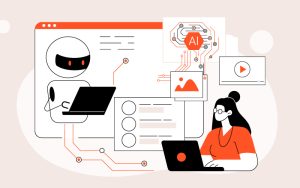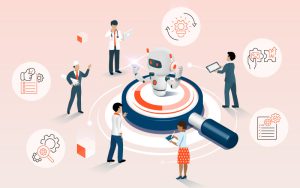
What If Immersive Learning Didn’t Require a Headset?
You don’t need a VR headset to create training that feels real. In actuality, virtual reality isn’t even necessary for some of the most captivating online learning environments. Instead, they imitate actual decisions, encourage introspection, and promote habit modification using AI-powered scenarios. When developed with platforms like BrinX.ai, this method of immersive training without virtual reality is already revolutionizing how businesses provide compliance, onboarding, and soft skills education.

The Problem: Traditional Training Doesn’t Stick
The majority of corporate training still uses quizzes, narrative, and slides. Despite being economical, it is seldom ever used, much less remembered. Learners click through content passively, skimming material and skipping critical thinking. This approach leads to poor retention, weak engagement scores, and minimal behavior change.
And while VR training offers potential, it’s expensive, slow to build, and hard to scale across roles or regions.

The Shift: Immersive Learning Without the Hardware
Immersive training doesn’t require a virtual environment. It requires real cognitive and emotional engagement. That’s why AI-generated scenario-based learning is gaining ground.
Here’s how it works:
-
AI examines source documents, such as manuals, SOPs, and policies.
-
Scenarios are auto-generated to reflect realistic decisions or dilemmas.
-
Learners interact with branching choices, feedback, and consequences.
-
Designers polish and align content to instructional goals and tone.
It goes beyond simply making information simple to comprehend. Its goal is to assist individuals in using it in authentic work settings where it truly counts. Strong instructional design can help with it. Methods such as Gagne’s steps, Kolb’s learning cycle, and Bloom’s Taxonomy assist in advancing training from “knowing” to “doing,” “deciding,” and “reflecting.” Students are not only memorizing data when such concepts are included into a course. Because the training allowed them time to reflect and practice before it mattered, they are making better decisions.
Want to learn more about how AI compares to traditional tools? Explore how BrinX.ai stacks up.

What Makes It “Immersive”?
These AI-powered experiences offer:
-
Cognitive realism: Decisions tied to real tasks, not abstract knowledge checks.
-
Emotional connection: Scenarios reflect workplace pressure, ambiguity, or ethical tension.
-
Immediate feedback: Learners see consequences of their choices, strengthening recall.
-
Adaptive paths: The narrative shifts based on learner input, simulating real-world complexity.
This isn’t “choose your own adventure” gamification. It’s a scalable way to embed behavioral rehearsal into your learning stack, without needing Unity developers or VR rigs.

Real-World Use Case: BrinX.ai in Action
Let’s say your compliance team needs to launch new anti-bribery training across 10 markets. With BrinX.ai:
-
You upload your latest policy PDF.
-
The AI analyzes key risks and role-specific issues.
-
Scenario flows are built, tailored to frontline managers, sales, and finance.
-
Interactive modules include choices, consequences, and reflections.
-
Designers at BrinX refine language, localize tone, and align to brand.
-
You receive SCORM-ready courses for your LMS in days, not months.
No VR required. Just real immersion and behaviorally anchored learning.
“The AI scenarios nailed our tone and use cases. What would’ve taken us six weeks internally was done and reviewed in six days.”

Key Takeaways for L&D Teams
-
Immersion is about engagement, not equipment.
-
AI scenarios provide scale and relevance, fast.
-
Instructional designers are still essential to ensure clarity and alignment.
-
Tools like BrinX.ai let L&D focus on impact instead of manual build tasks.

Common Mistakes to Avoid
Immersion is about engagement, not equipment.
AI scenarios provide scale and relevance, fast.
Instructional designers are still essential to ensure clarity and alignment.
Tools like BrinX.ai let L&D focus on impact instead of manual build tasks.

FAQs
What is adaptive learning, and how does AI contribute to it?
Adaptive learning adjusts the experience to the performance, preferences, and speed of individual learner. By altering the trip based on real-time data analysis of what a learner clicks, skips, or struggles with, artificial intelligence improves this.
Can AI really generate full courses from raw content?
Yes. Certain AI-powered services can analyze SOPs, manuals, and slide decks to generate structured modules with assessments and objectives. Although they significantly cut down on production time, these drafts still benefit from human inspection.
How is gamification supported by AI?
AI doesn’t create game mechanics, but it sets the foundation. It structures learning into modules, which instructional designers can then gamify, adding points, scenarios, or progress indicators that motivate learners.
What’s the benefit of combining AI and microlearning?
Complex material is decomposed by AI into goal-aligned, modular building pieces that are ideal for microlearning. This facilitates the creation of brief, efficient, and time-spaced learning excursions that improve retention.
Is this approach scalable across a global workforce?
Yes. AI-assisted course development is particularly effective at scaling training in domains where consistency is crucial and source information is already available, such as compliance, product knowledge, and onboarding.
Do I need to buy a platform to use this kind of AI course builder?
Not always. Some services, like the one developed under MITR, offer course generation as a project-based model, no platform lock-in, no licenses, just a secure workflow and editable output.
Can human instructional designers still add value after AI builds the draft?
Absolutely. In fact, they’re essential. AI handle’s structure and speed; humans bring voice, empathy, and interactivity. It’s not either-or, it’s a partnership.
How secure is this process when using sensitive documents?
Best-in-class tools encrypt content, never store source material beyond delivery, and meet enterprise privacy standards. Always check for data handling policies before sharing internal content.

Soft Skills Deserve a Smarter Solution
Soft skills training is more than simply information. It is about influencing how individuals think, feel, and act at work, with coworkers, clients, and leaders. That requires intention, nuance, and trust.






